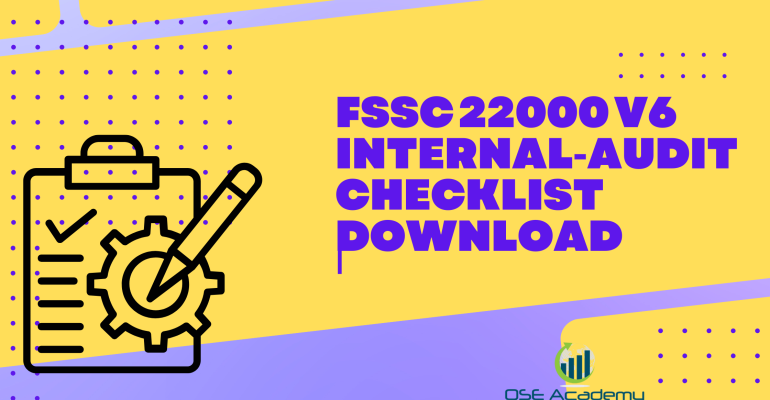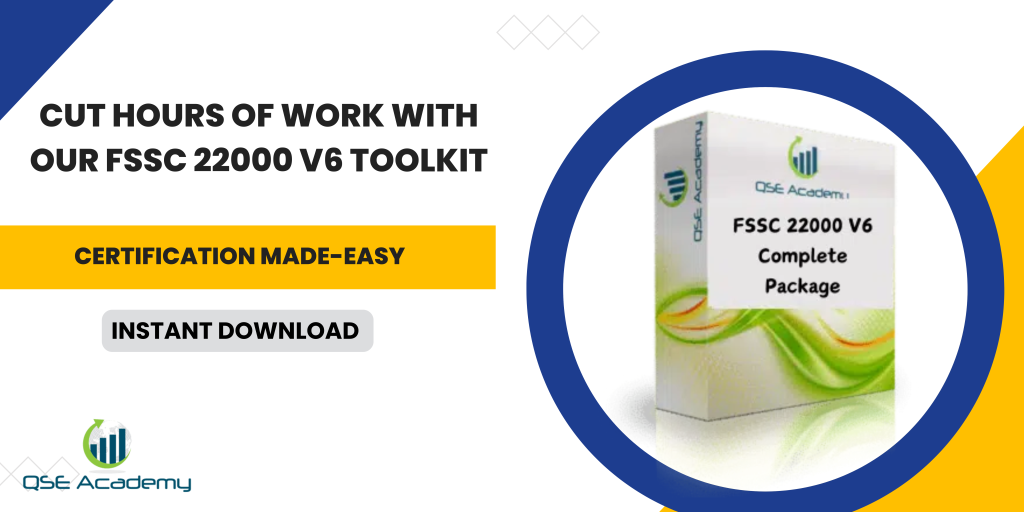FSSC 22000 V6 Internal‑Audit Checklist Download
The Smart Way to Audit Your Own System
At QSE Academy, we’ve seen how internal audits make or break certification success.
Too often, teams treat them like a formality—something to “get out of the way” before the real audit.
But that mindset costs companies time and credibility.
A well-planned internal audit does more than tick boxes—it reveals how strong your Food Safety Management System (FSMS) truly is.
This article shows you exactly how to use the FSSC 22000 V6 Internal-Audit Checklist to spot weaknesses, verify compliance, and drive real improvement across your operations.
Why Internal Audits Matter Under FSSC 22000 V6
Internal audits aren’t just an ISO requirement—they’re your first defense against non-conformities.
They confirm whether your FSMS meets ISO 22000:2018, the applicable PRP standard (ISO/TS 22002 series), and FSSC 22000 V6’s additional requirements.
When done right, they prepare your team for the certification audit long before the auditor steps on-site.
Pro Tip:
Treat your internal audit like a “mock external audit.” It’s your chance to find what an auditor would find—without the pressure of grades or deadlines.
Example:
A beverage plant we worked with reduced external findings by 60% simply by using a structured internal-audit checklist for three consecutive quarters.
 What the FSSC 22000 V6 Internal-Audit Checklist Covers
What the FSSC 22000 V6 Internal-Audit Checklist Covers
The checklist is structured around the key pillars of FSSC 22000 V6, ensuring no requirement is missed.
a. Management Commitment & Food-Safety Policy
- Verify management’s active role in food-safety objectives.
- Check that policies are communicated and understood.
- Review management-review records and culture initiatives.
Common Mistake: Policies that exist on paper but not in people’s minds.
b. Hazard Analysis & HACCP Plan
- Confirm hazard analysis is current and validated.
- Ensure CCPs and OPRPs are monitored and recorded properly.
- Review flow diagrams and team competence.
Pro Tip: Keep a visible “last validation date” note on each HACCP file—it shows ongoing control.
c. PRP Implementation
- Review hygiene, sanitation, pest control, and maintenance records.
- Check alignment with ISO/TS 22002 standards.
- Confirm cleaning verification and calibration are up to date.
Example: A frozen-food client used the checklist’s PRP section to uncover overlooked calibration lapses—before the auditor did.
d. Operational Controls & Traceability
- Verify process controls, CCPs, and traceability records.
- Test a mock recall for timing and completeness.
- Review product identification and labeling compliance.
Common Mistake: Incomplete trace-forward records that stop at packaging instead of reaching the supplier level.
e. Internal Audits, CAPA & Continual Improvement
- Ensure internal audits cover all clauses annually.
- Check corrective actions are implemented and verified.
- Review continual improvement logs and effectiveness records.
Pro Tip: Show your internal-audit schedule alongside previous findings—it demonstrates a proactive, cyclical approach.
f. Food-Defense, Food-Fraud, and Allergen-Control
- Review documented vulnerability and threat assessments.
- Verify mitigation actions and staff awareness.
- Confirm allergen segregation and cleaning validation.
Common Mistake: Having a food-fraud plan but no evidence of annual review or supplier risk updates.
g. Documentation & Record Control
- Check that all SOPs and forms are current and approved.
- Verify accessibility and retention consistency.
- Confirm obsolete versions are removed from circulation.
Pro Tip: A simple document-control matrix linking each procedure to its clause keeps auditors impressed and your team organized.
How to Use the Checklist Effectively
Step 1: Plan Your Audit Schedule
Cover all processes and clauses within a year. Prioritize high-risk areas first.
Step 2: Assign the Right Auditors
Auditors should be trained and independent of the processes they audit.
Step 3: Use the Checklist in Real Time
Don’t just tick boxes. Ask operators to demonstrate how tasks are performed.
Step 4: Grade and Record Findings
Mark each item as conforming, minor, or major—and note supporting evidence.
Step 5: Review and Improve
Summarize findings in your management review meeting and plan follow-ups.
Pro Tip:
Keep the checklist dynamic—update it when standards, processes, or customer requirements change.
Common Internal-Audit Mistakes
Even the most experienced teams can fall into routine traps.
Typical Issues:
- Auditing only documents, not operations.
- Using generic templates that ignore specific PRPs.
- Failing to verify that corrective actions were effective.
How to Avoid Them:
Customize your checklist for your facility.
Integrate previous findings directly into the new audit plan.
And schedule short refresher sessions for auditors before each cycle—confidence builds consistency.
Benefits of Using a Structured Internal-Audit Checklist
- Covers all FSSC 22000 V6 clauses and PRP requirements.
- Brings consistency across multiple sites or departments.
- Simplifies tracking of findings and corrective actions.
- Builds confidence and readiness before external audits.
Example:
A dairy processor we supported used the QSE Academy checklist quarterly. By their certification audit, they had zero non-conformities tied to internal audits—a perfect record.
FAQs — Internal-Audit Checklist Use
Q1. How often should we perform internal audits?
At least once a year, but critical processes should be reviewed more often.
Q2. Can a person audit their own work?
No. Independence is key. Assign auditors from different departments.
Q3. Do we need a specific report format?
No standard format, but reports must show scope, criteria, findings, and conclusions. The checklist automatically organizes this information for you.
Conclusion — Turn Internal Audits into a Strength
Internal audits aren’t just about compliance—they’re your continuous improvement engine.
When your team uses the right checklist, they stop fearing audits and start learning from them.
At QSE Academy, we’ve built the FSSC 22000 V6 Internal-Audit Checklist to help you cover every clause, PRP, and requirement with confidence.
If you’re ready to audit smarter, download our Internal-Audit Checklist (Excel/PDF) or book a training session for your audit team today.
Audit readiness starts long before the auditor arrives—and it starts here.
Melissa Lavaro is a seasoned ISO consultant and an enthusiastic advocate for quality management standards. With a rich experience in conducting audits and providing consultancy services, Melissa specializes in helping organizations implement and adapt to ISO standards. Her passion for quality management is evident in her hands-on approach and deep understanding of the regulatory frameworks. Melissa’s expertise and energetic commitment make her a sought-after consultant, dedicated to elevating organizational compliance and performance through practical, insightful guidance.








